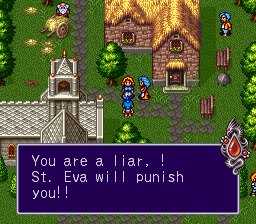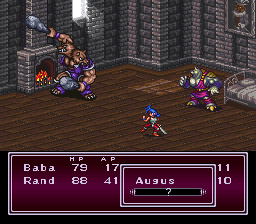The Breath of Fire series has never seen the same level of success as fellow RPG series, such as Final Fantasy or Dragon Quest. Yet it boasts a strong cult following even to this day, despite its last major entry (as of this writing) being released in 2003, although a new game in the series, Breath of Fire 6: Guardians of the White Dragon, is in development for mobile devices. Its focus has always been on a character named Ryu and his ability to transform into a dragon, a power not often tackled by other games. Capcom was not (and still isn't) known for their RPG prowess, and perhaps this led consumers astray. Nonetheless, the Breath of Fire series is a competent project, with the PlayStation entries being the peaks of quality. Breath of Fire II isn't quite up to that standard, but it sure as heck tries.
In the world of Breath of Fire II, poverty is far more rampant than you'd expect. Innocent citizens have become poor and live in bathrooms featuring stopped-up toilets. (I was impressed by how many toilets were declared "stopped up" in Breath of Fire II. One is too many.) People the world over are falling to the teachings of St. Eva, evident by even the smallest of towns having elaborate churches. In one such town lives Father Ganer, his daughter Yua, and you, his son Ryu. When Yua runs into the forest, Ryu is ordered to chase after her, and in doing so, he finds her sleeping there beneath the protection of a huge dragon. Yua says that when she naps there, she can see her mother in her dreams. Ganer and Yua return to town, but Ryu opts for a brief dirt nap. The eye of a devil, claiming itself to be God, glares intently within this nightmare. Upon awakening, he discovers that everything in his home town is different, and no one recognizes him. Ryu's journey begins here: to find out where his life went and how things can get back to normal.
One point I thought was shocking was how much focus is paid to religion, especially considering Nintendo's strict policies on including such things in games, at least in overseas markets. Breath of Fire II covers up nothing: the very first byte of dialogue in the entire game asks you to give yourself to God. Through
Breath of Fire II is your standard RPG. The majority of your time will be spent battling enemies in a turn-based combat system. Either in dungeons or on the world map, wandering around will lead to random encounters, pulling you immediately into battle. Each character in your four-person party (out of, eventually, a choice of nine) will have the option to perform a physical attack, whip out their own special move, cast a spell (a "Spl." — thanks, character limits), or use an item from your inventory — all typical classic RPG elements. These "special moves" aren't particularly notable. With the exception of Bow, most special moves are as impressive as receiving a fruitcake as a holiday gift. (That is, you'd rather take the fruitcake and hurl it through their living room window than sit down with a fork and gnaw away at that awful concoction of discarded fruit bits and bricked lard.) You're more likely to rely on physical attacking and use of magic if you actually want to get ahead and win. The remainder of your precious time will be spent simply enjoying the scenery or talking to every townsperson imaginable to get information on your next course of action. The battle system isn't innovative, but it
Unfortunately, this is my biggest gripe with Breath of Fire II: its impressively awful translation. Speech is extremely unnatural, and it's not always clear what citizens are saying or why they are saying it. Sadly, no one has any use for punctuation either, as it's surprisingly absent on so many occasions. What's worse is that this lack of translation really affects knowing where you need to go next, as the game is already pretty opaque on its instructions. There's a part where, in order to learn the teachings of St. Eva before invading the Grand Church, you have to make a donation at one of the smaller churches in the world. But what the game FAILS to tell you is that you don't have to make just one donation: you have to make TWENTY. So if you were to give your donation once expecting something to happen, you'd be outright confused. Nothing happened other than a thank-you from the Father. What do I do now?
Other translation gaffes make themselves apparent from the start of the game. Once we get past the introductory scene of Ryu as a child and progress into Ryu's grown-up life as a Ranger, we learn the name of his city of residence: HomeTown. Seriously? They couldn't pick a better name for Ryu's home town than "HomeTown"? Did Capcom put ANY funding into this localization, other than maybe a free bucket of fried chicken? There's another town that you actually build up yourself (a nice addition, by the way) by recruiting those in need of a change in life, but what name did Capcom give it? TownShip. How creative. I'd like to hire that translator for my next BthdyPty. It's a shame you can't rename it to something more palpable like SuperDot or Jeffburg. Worse yet, there's a part where the game tells you to go to HomeTown, but really, they mean TownShip. What a goof! Most people will be rather lost at this point, if they are able to get this far.
I really do loathe the character limit imposed. Why can't party member names ever be more than four characters long? This is not an early NES game; this is the SNES in 1995. I think we can count past four. It leads to names like "Sten". What kind of a name is STEN? Remember that one popular guy in school all the girls swooned over and clung to at recess? What was his name again? Oh yeah — it sure as heck wasn't STEN! The inventory suffers from a similar fate. What is a "HelpBL"? An "F.Spice"? A "NoTwinRP"? A "KingOfDR"? Who truly is the King of DR? I am.
And don't even ask me what a "HolySH" is, because you might not like the answer.



This game punishes you fairly often, mostly with unnatural dialogue.
If all THAT wasn't bad enough, one of the last lines in the game's ending says it all: "Thank you so match for playing." Let's light a match and set this game on fire — give it a breath of fire. Or an engulfment.
Errr...looks like I got a bit side-tracked there. Back to business! One of Breath of Fire II's features is the ability to unite party members with spirits. Depending on who is united with which spirit (and not everyone is compatible with every spirit, mind you), the character will earn stat gains and, in many cases, they'll actually experience a VERY noticeable physical change. My only gripe with this is that if a party member is killed or at least severely injured, they'll lose their unity and have to go back to TownShip for a reunion of sorts. Ryu can be fused with spirits, too, but no stat boost can compare to the might of his dragon powers! Raw-awr!
As a video game in and of itself, Breath of Fire II is generally well done. The graphics have a similar flair to the first Breath of Fire game but are ever so slightly more lighthearted and detailed. The music is decent as well, although it has a strong tendency to repeat itself throughout the game; I would have preferred a bit more variety, although I appreciate that the world map theme changes between major sections of the game. The battle theme stuck out, mostly because of the pseudo chorused guitar, because I recognized its heavy use in Mega Man X... and sure enough, it's the same composer! Other notable themes include the warm and welcoming "My Home Sweet Home" theme and the rather chilling "No One Remembers" opening theme, the latter being a worthy contender to some popular melancholy Final Fantasy tunes.
I also am thankful that, with a fairly large party of nine, that attention was paid to character development, giving each party member their own scenario for you to play through to learn more about their history and motivations for supporting Ryu. We see an extensive scenario for Jean, the frog prince that has since been usurped from his throne by an imposter, and another for the aforementioned well-named Sten, who, though initially portrayed as just some immature monkey goofball, is actually a respected warrior that fled from his species' war in cowardice.
Breath of Fire II isn't perfect. It doesn't offer much in terms of innovation, preferring to settle in a tried-and-true formula. Its translation is nearing the bottom rung of the quality ladder, leading many players (myself included) into confusion as to what to do next. But if you can look past its major flaws, you can find a game that's rather enjoyable, provided you have a walkthrough handy for the game's extremely cryptic moments and aren't afraid of a little challenge. It won't blow you away, but it will keep classic RPG fans satisfied.


